Tara Chevrestt's Blog, page 46
September 5, 2014
Lies, Deceit, Brutality... The Boleyn Reckoning (The Boleyn Trilogy #3) by Laura Andersen
 ...where there were kings and princesses and bishops and heretics, there would be trouble. And secrets. And more than enough of both.
...where there were kings and princesses and bishops and heretics, there would be trouble. And secrets. And more than enough of both.The third installment in the "what-if" series about the real Anne Boleyn's imaginary son shocked the bejesus out of me.
I enjoyed the first two, The Boleyn King and The Boleyn Deceit. I loved how there was a murder mystery in the middle of everything and became so immersed in the characters' lives and loves, I was very excited to read this.
I def didn't enjoy this much as the other two though. First of all, there's no real mystery, not like there was in the previous two, and second, this story, the last half anyway, was just full of incredible hate, evil, and brutality. It just became something ugly after the 50% point.
The writing is fabulous; I just don't care for where the author took this trilogy. There also wasn't enough Elizabeth and I grew so very, very frustrated with Min and Dominic and their incredibly stupid decisions. I kept screaming at my Kindle, "Don't admit it! What's one more lie after all this time? You're stupid! Quit hiding this or that, stop trying to please him, to hell with honor. Fight for what you want!" I hated Min this time and thought her tiptoeing around William and all this "I'm torn between two men" crap had just gone on long enough. What she does in the end...ugh. Hell no. Made me want to vomit. Was she just looking for excuse to go from one bed to the other? 'Cause she did herself and Dom no favors.
The fact I was so angry goes to show just how immersed I was though, so in a way, my extreme frustration with the characters is a compliment to the author. She writes a darn good yarn that really sucks you in. As I said above, I just hated how very ugly this got, mostly on William's part and yet a part of me couldn't blame him.
And I'd have liked MORE Elizabeth. As in the other two titles, she was more a background figure and yet she was my favorite character. The fact this one def focused on Min--who'd I came to dislike tremendously--and less on Elizabeth just made it not as enjoyable for me, though the beheadings, wars, secrets, and court intrigue kept me reading long after I should have fallen asleep.
Def a must for Tudor fans if you don't mind how very ugly it gets.
I received a digital galley through Netgalley.

Published on September 05, 2014 00:00
September 4, 2014
Heart-Stopping Adventure and A Lovable Hero Make Monsoon Mists a Sure Winner
 I rarely say this. Those of you who read my reviews know that I'm not really into heroes. I tolerate male POVs. They're okay. It's the heroines I really pay attention to tho...
I rarely say this. Those of you who read my reviews know that I'm not really into heroes. I tolerate male POVs. They're okay. It's the heroines I really pay attention to tho...But Ms. Courtenay has created the perfect hero, and I have fallen absolutely in love with Jamie. He's a fighter, a lover, he's honorable and he has just the right amount of arrogance--just enough to ensure he's confident in himself and doesn't need to remind everyone constantly. He is a self-assured hottie. And he cares about kids and dogs. Truly a man after my heart!
And oh, he's a tease. When he speaks to Zar, flirts with her, or even just makes a joke about rowing with one ore and going in circles, I chuckled or smiled and melted inside all over again.
And Zar can hold her own as well. Though she's not a warrior woman, she faces a lot of bad situations and doesn't break down. She is a survivor. She's survived a bad marriage, a cruel stepson, and assault. She's also highly intelligent, so intelligent that her deceased husband left her half of his trading business when he died...and this is a time period and country (India, 1700s) when that was NOT done. She's also extremely adamant that she not wed again and be controlled by a man. Kudos to her!
Besides two awesome main players, the book also has another aspect in its favor: a ton of adventure. There's a stolen jewel, an abducted family, a tricky situation playing courier for a dangerous item, pirates, and as always when a valuable item is involved--a ton of greedy people who want it for their own reasons and will stop at nothing to get said item. So while it's in Jaime's possession....well....trouble keeps finding him.
And even better, Courtenay manages to place a lovable dog in the story, who in a way, saves the day!
Bit preposterous, far fetched at times, but a thoroughly enjoyable read. I even enjoyed the sex scene, another rare thing for me. Well done, Courtenay!
I received this in digital galley format from the publisher.

Published on September 04, 2014 00:00
September 3, 2014
Close to the Sun Follows the Adventurous Lives of WWII Aviators (HFVBT)

Thank you to Historical Fiction Virtual Book Tours for providing a digital copy of this for my reading pleasure.
I don't normally read "man" books, but I was drawn to this because of the aviation theme. It follows three different men as they pursue their dreams of flying pursuit planes and enter WWII. One man is a German. I had a hard time enjoying his stories. His personality was that of a jerk. One is a Jewish American. Something didn't grab me about his bits. Even his romance was uninteresting to me.
But then we have Hank and I really, really like Hank. All his parts were interesting to me: the girl Winty, his experience in cadet school, the men he knows (like the Texan), motorcycle races... I learned a lot about how early Army Air Force training was like--from the hazing to the lack of flight time to the pursuit vs bombers issue. I had no idea that bombers were "uncool". Don't seem one bit uncool to me!
The book can drag if you're not interested in one or two of the main characters, but if you like the characters and have an interest in aviation history, this is for you. Matter of fact, I got my husband a copy of this one.
***
Publication Date: June 15, 2014
Fireship Press
eBook; 404p
Genre: Historical Fiction

Close to the Sun follows the lives of fighter pilots during the Second World War. As a boy, Hank Milroy from Wyoming idealized the gallant exploits of WWI fighter aces. Karl, Fürst von Pfalz-Teuffelreich, aspires to surpass his father’s 49 Luftsiegen. Seth Braham falls in love with flying during an air show at San Francisco’s Chrissy Field.
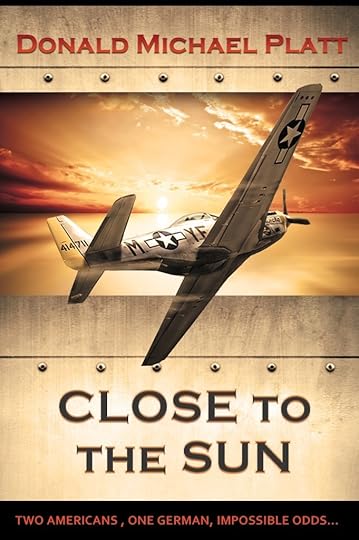 The young men encounter friends, rivals, and exceptional women. Braxton Mobley, the hotshot, wants to outscore every man in the air force. Texas tomboy Catherine “Winty” McCabe is as good a flyer as any man. Princess Maria-Xenia, a stateless White Russian, works for the Abwehr, German Intelligence. Elfriede Wohlman is a frontline nurse with a dangerous secret. Miriam Keramopoulos is the girl from Brooklyn with a voice that will take her places.
The young men encounter friends, rivals, and exceptional women. Braxton Mobley, the hotshot, wants to outscore every man in the air force. Texas tomboy Catherine “Winty” McCabe is as good a flyer as any man. Princess Maria-Xenia, a stateless White Russian, works for the Abwehr, German Intelligence. Elfriede Wohlman is a frontline nurse with a dangerous secret. Miriam Keramopoulos is the girl from Brooklyn with a voice that will take her places.Once the United States enter the war, Hank, Brax, and Seth experience the exhilaration of aerial combat and acedom during the unromantic reality of combat losses, tedious bomber escort, strafing runs, and the firebombing of entire cities. As one of the hated aristocrats, Karl is in as much danger from Nazis as he is from enemy fighter pilots, as he and his colleagues desperately try to stem the overwhelming tide as the war turns against Germany. Callous political decisions, disastrous mistakes, and horrific atrocities they witness at the end of WWII put a dark spin on all their dreams of glory.
Blogger Praise for Close to the Sun"Donald Michael Platt’s Close to the Sun is an amazing story told from the perspective of average male fighter pilots in the onset and during WWII, juxtaposing between various men from many sides of the war. The details in this novel were spectacular, creating imagery and depth in the scenes and characters, as well as the dialogue being so nostalgic and well-written it felt right out of a 1950’s film. The romantic nuances of his storytelling felt incredibly authentic with the tug and pull of the men being called to serve and the women whom they loved who had their own high hopes, dreams, or work. I loved how he portrayed this women the most—strongly and fiercely independent. I’ve read several other books by Platt, and this is the best one I’ve read yet! I couldn’t stop reading. " - Erin Sweet Al-Mehairi, Hook of a Book
"Donald Platt's Close To The Sun, is nothing short of Historical Fiction gold. Platt's flair for emotionally provocative storytelling makes this book attractive to both male and female readers. Seamlessly weaving the threads of action and feeling into a brilliant tableau of humanity. This is a masterfully penned tale of war, ambition, love, loss, and ACES!" - Frishawn Rasheed, WTF Are You Reading?
"Fast-paced and riveting I couldn’t get enough of Hank, Karl and Seth’s exploits! CLOSE TO THE SUN is a thrilling novel that leads readers through idyllic dreams of heroism and the grim reality of war. Platt provides readers with a unique coming-of-age story as three adventure-seeking boys discover far more than how to be an aerial combat pilot. CLOSE TO THE SUN is an amazing tale of adventure, heroism, war and the drive within us all that keeps us going when things look bleak." - Ashley LaMar, Closed the Cover
"I found Close to the Sun to be an entertaining read, it was well written, with well developed characters, these characters had depth and emotion. A unique plot, told from the point of view of pilots prior to and during World War II. It was a well researched and interesting book" - Margaret Cook, Just One More Chapter
Buy the BookAmazon
Barnes & Noble
About the Author
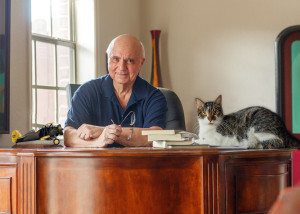 Author of four other novels, ROCAMORA, HOUSE OF ROCAMORA, A GATHERING OF VULTURES, and CLOSE TO THE SUN, Donald Michael Platt was born and raised in San Francisco. Donald graduated from Lowell High School and received his B.A. in History from the University of California at Berkeley. After two years in the Army, Donald attended graduate school at San Jose State where he won a batch of literary awards in the annual SENATOR PHELAN LITERARY CONTEST.
Author of four other novels, ROCAMORA, HOUSE OF ROCAMORA, A GATHERING OF VULTURES, and CLOSE TO THE SUN, Donald Michael Platt was born and raised in San Francisco. Donald graduated from Lowell High School and received his B.A. in History from the University of California at Berkeley. After two years in the Army, Donald attended graduate school at San Jose State where he won a batch of literary awards in the annual SENATOR PHELAN LITERARY CONTEST.Donald moved to southern California to begin his professional writing career. He sold to the TV series, MR. NOVAK, ghosted for health food guru, Dan Dale Alexander, and wrote for and with diverse producers, among them as Harry Joe Brown, Sig Schlager, Albert J. Cohen, Al Ruddy plus Paul Stader Sr, Hollywood stuntman and stunt/2nd unit director. While in Hollywood, Donald taught Creative Writing and Advanced Placement European History at Fairfax High School where he was Social Studies Department Chairman.
After living in Florianópolis, Brazil, setting of his horror novel A GATHERING OF VULTURES, pub. 2007 & 2011, he moved to Florida where he wrote as a with: VITAMIN ENRICHED, pub.1999, for Carl DeSantis, founder of Rexall Sundown Vitamins; and THE COUPLE’S DISEASE, Finding a Cure for Your Lost “Love” Life, pub. 2002, for Lawrence S. Hakim, MD, FACS, Head of Sexual Dysfunction Unit at the Cleveland Clinic.
Currently, Donald resides in Winter Haven, Florida where he is polishing a dark novel and preparing to write a sequel to CLOSE TO THE SUN.
For more information please visit Donald Michael Platt's website. You can also connect with him on Facebook and Twitter.
Close to the Sun Blog Tour ScheduleMonday, August 18
Review at Forever Ashley & Closed the Cover
Wednesday, August 20
Spotlight at A Bookish Affair
Thursday, August 21
Review at Tribute Books Mama
Friday, August 22
Spotlight at CelticLady's Reviews
Saturday, August 23
Review at Beth's Book Reviews
Monday, August 25
Review at Jorie Loves a Story
Tuesday, August 26
Interview at Jorie Loves a Story
Wednesday, August 27
Spotlight at Princess of Eboli
Thursday, August 28
Guest Post at The Writing Desk
Friday, August 29
Review at Queen of All She Reads
Monday, September 1
Review at Book Nerd
Tuesday, September 2
Review & Guest Post at My Tangled Skeins Book Reviews
Wednesday, September 3
Review at Book Babe
Thursday, September 4
Spotlight at Layered Pages
Spotlight at Kinx's Book Nook
Friday, September 5
Guest Post at Cynthia Robertson Blog
Published on September 03, 2014 00:00
September 2, 2014
Rav Hisda's Daughter: Enchantress Blog Tour Stop and Author Interview
I was fascinated by Rav Hisda's Daughter: Apprentice because it showed us a Jewish world that is so radically different than the one that I was accustomed to seeing. See my review on my former blog that was titled But Is It Really Jewish Magic? That first Rav Hisda's Daughter novel caused me to realize that a revolution happened in Judaism in the fourth century C.E. I couldn't wait to read and review the sequel and was delighted to have the opportunity to be part of the blog tour for the release of Rav Hisda's Daughter: Enchantress.
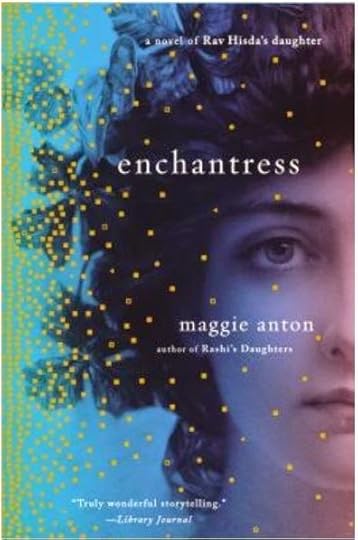
Maggie Anton's second book about the Jewish scholar and magical practitioner who she calls Hisdadukh, is far more fantasy oriented than the first volume. Demons appear and a mysterious magical artifact surfaces as Hisdadukh ascends through the hierarchy of sorceresses in the Jewish communities of ancient Persia. We learn that a number of eminent women were sorceresses and that they were as integral to the Judaism of the time as the Rabbis who also had a secret tradition of magical practices. I had to come to the conclusion that I couldn't simply categorize this book as a historical novel. Yes, it's certainly historical, but there's another fully developed dimension beyond the historical.
Let me explain how I slice and dice genre in this context. When an author portrays a character as casting spells in a traditional manner, this can be regarded as an accurate portrayal of ancient practice in a non-genre historical fiction book. People who don't believe that spells work can say to themselves that there is an alternate explanation for the success of those spells. In this book a demon manifests in a public setting so that it's perceivable by a large number of people . Another demon becomes an ongoing character in the novel. Such fantastical events aren't so amenable to a skeptical worldview. The reader must engage in voluntary suspension of disbelief. I would therefore shelve Enchantress as historical fantasy next to the highly successful historical fantasy, The Golem and the Jinni by Helene Wecker.
One way in which this novel is quite different from Wecker's is that the characters evolve over the course of the narrative. I wish that the Golem and Jinni could have emerged from their stereotypical boxes. Anton's protagonists, Hisdadukh and Rava, are portrayed as human beings who grow and change during their lifetimes.
As I was reading the book, I questioned the development of Hisdadukh into a woman who prioritized status and power. Yet she still maintained the pursuit of knowledge as a main goal as well as the strength of her family and community. Status and power were intended to serve those goals. She didn't become distracted or corrupted by her increased status and power as some other characters did. I found that very admirable.
Rava had a dark side to his character. His enduring failings were arrogance and rage in response to any challenge. Since I have little tolerance for people who refuse to admit that they can make mistakes, I originally thought that he couldn't have any successful relationships. On the other hand, I admit that he did have some commendable traits. His brilliant mind, heroism and loyalty do go a long way to compensate for a rampant ego. He also eventually showed some regret over the results of his own bad behavior which demonstrates growth. The revelations about the difficult past that formed his character also made him more sympathetic.
I recommend this book to readers who want to see a fully realized Jewish society where building the Talmud and practicing magic were both considered Jewish activities.
Now I would like to welcome Maggie Anton to Book Babe to ask her a few questions about the Rav Hisda's Daughter books.
Shomeret:
You call your central character Hisdadukh, which means Hisda’s daughter in Persian. I’m sure you’re aware that there were Jews who thought that mentioning the name of a woman compromised her because it was considered immodest. Could it be that Rav Hisda’s daughter had a name other than Hisda’s daughter which was never mentioned to protect her modesty? Why did you decide that she had no other name?
Maggie Anton:
My novels are about real historical figures, so I am a stickler for accuracy. For example, for a female character that has no recorded name, I won’t make one up until I research what were popular names for women in her community. I couldn’t leave Hisda’s daughter nameless – she was my heroine. But I clearly couldn’t use other female names from the Talmud because they already belonged to those women. When I learned about Babylonian Incantation Bowls, where people were inscribed with their mothers’ names, I came across a trove of Jewish females names from 4th-6thcentury Iraq. About a third of them were xxx-dukh, so I concluded that it was possible that the Talmud called her “Hisda’s daughter” not necessarily to protect her modesty, but because that was her name. Other women in the Talmud have names, but rather than pick one from the bowls at random, I decided to call her Hisdadukh. If I guessed wrong, who will know?
Shomeret:
As in the first Rav Hisda’s Daughter novel, there are discussions of Talmud cases in Enchantress. One was a rather bizarre case involving a borrowed cat. I found it at The Talmudic Case of the Borrowed Cat which is in Baba Metziah. Did you worry that some readers would be alienated by not wanting to read about terrible things happening to animals?
Maggie Anton:
It never occurred to me that this odd story would upset my readers; nor that this was such a popular Talmudic case on the Internet. I’m a cat person myself and I liked the idea that people with rodent problems would borrow or rent a cat to deal with it. I assume that the cat died of something else and the unhappy cat’s owner wanted to hold the borrower responsible. I wanted to show that not all Talmudic arguments involved weighty religious subjects.
Shomeret:
Astrology is part of the lives of the characters in the Rav Hisda’s Daughter books. Although my own great grandfather was a Rabbi who consulted an astrologer, I know that many Jews would characterize those who believe in astrology as “Ovdei Kochavim” or worshipers of the stars in English. What would you say to people who maintain that it’s unthinkable that Rabbis of the generation that created the Talmud could have consulted astrologers?
Maggie Anton:
I would say that in those days, everyone consulted astrologers. In Babylonia some were knowledgeable astronomers, who not only understood the movement of heavenly bodies, but could calculate their positions in the past. The rabbis, along with other Jews, didn’t worship the stars, but rather believed that God created them and set them in motion, and that by studying their movements one could learn all sorts of things. After all, the sun affected how plants grew and the moon regulated the tides. The Talmud, in Tractate Shabbat, has a lengthy sugia about which planet rules which day and hour and how that impacts people’s actions. Each heavenly body was associated with a specific Jewish angel, whose influence ruled that day and hour.
Shomeret:
What book are you working on next? Can you tell us anything about it?
Maggie Anton:
The story of Rav Hisda’s daughter is complete. I have no contract with Penguin for any specific work, though they have the first option on the next book I do write. Right now I’m focused on promoting Enchantress, but I admit that there is a story rattling around in my head that won’t leave. When I have time, I’ll try writing it down, but I don’t want to tempt the Evil Eye by saying more about it now ;)
Shomeret:
Thank you, Maggie Anton, for your illuminating responses. I will look forward to your future works.

Maggie Anton's second book about the Jewish scholar and magical practitioner who she calls Hisdadukh, is far more fantasy oriented than the first volume. Demons appear and a mysterious magical artifact surfaces as Hisdadukh ascends through the hierarchy of sorceresses in the Jewish communities of ancient Persia. We learn that a number of eminent women were sorceresses and that they were as integral to the Judaism of the time as the Rabbis who also had a secret tradition of magical practices. I had to come to the conclusion that I couldn't simply categorize this book as a historical novel. Yes, it's certainly historical, but there's another fully developed dimension beyond the historical.
Let me explain how I slice and dice genre in this context. When an author portrays a character as casting spells in a traditional manner, this can be regarded as an accurate portrayal of ancient practice in a non-genre historical fiction book. People who don't believe that spells work can say to themselves that there is an alternate explanation for the success of those spells. In this book a demon manifests in a public setting so that it's perceivable by a large number of people . Another demon becomes an ongoing character in the novel. Such fantastical events aren't so amenable to a skeptical worldview. The reader must engage in voluntary suspension of disbelief. I would therefore shelve Enchantress as historical fantasy next to the highly successful historical fantasy, The Golem and the Jinni by Helene Wecker.
One way in which this novel is quite different from Wecker's is that the characters evolve over the course of the narrative. I wish that the Golem and Jinni could have emerged from their stereotypical boxes. Anton's protagonists, Hisdadukh and Rava, are portrayed as human beings who grow and change during their lifetimes.
As I was reading the book, I questioned the development of Hisdadukh into a woman who prioritized status and power. Yet she still maintained the pursuit of knowledge as a main goal as well as the strength of her family and community. Status and power were intended to serve those goals. She didn't become distracted or corrupted by her increased status and power as some other characters did. I found that very admirable.
Rava had a dark side to his character. His enduring failings were arrogance and rage in response to any challenge. Since I have little tolerance for people who refuse to admit that they can make mistakes, I originally thought that he couldn't have any successful relationships. On the other hand, I admit that he did have some commendable traits. His brilliant mind, heroism and loyalty do go a long way to compensate for a rampant ego. He also eventually showed some regret over the results of his own bad behavior which demonstrates growth. The revelations about the difficult past that formed his character also made him more sympathetic.
I recommend this book to readers who want to see a fully realized Jewish society where building the Talmud and practicing magic were both considered Jewish activities.
Now I would like to welcome Maggie Anton to Book Babe to ask her a few questions about the Rav Hisda's Daughter books.
Shomeret:
You call your central character Hisdadukh, which means Hisda’s daughter in Persian. I’m sure you’re aware that there were Jews who thought that mentioning the name of a woman compromised her because it was considered immodest. Could it be that Rav Hisda’s daughter had a name other than Hisda’s daughter which was never mentioned to protect her modesty? Why did you decide that she had no other name?
Maggie Anton:
My novels are about real historical figures, so I am a stickler for accuracy. For example, for a female character that has no recorded name, I won’t make one up until I research what were popular names for women in her community. I couldn’t leave Hisda’s daughter nameless – she was my heroine. But I clearly couldn’t use other female names from the Talmud because they already belonged to those women. When I learned about Babylonian Incantation Bowls, where people were inscribed with their mothers’ names, I came across a trove of Jewish females names from 4th-6thcentury Iraq. About a third of them were xxx-dukh, so I concluded that it was possible that the Talmud called her “Hisda’s daughter” not necessarily to protect her modesty, but because that was her name. Other women in the Talmud have names, but rather than pick one from the bowls at random, I decided to call her Hisdadukh. If I guessed wrong, who will know?
Shomeret:
As in the first Rav Hisda’s Daughter novel, there are discussions of Talmud cases in Enchantress. One was a rather bizarre case involving a borrowed cat. I found it at The Talmudic Case of the Borrowed Cat which is in Baba Metziah. Did you worry that some readers would be alienated by not wanting to read about terrible things happening to animals?
Maggie Anton:
It never occurred to me that this odd story would upset my readers; nor that this was such a popular Talmudic case on the Internet. I’m a cat person myself and I liked the idea that people with rodent problems would borrow or rent a cat to deal with it. I assume that the cat died of something else and the unhappy cat’s owner wanted to hold the borrower responsible. I wanted to show that not all Talmudic arguments involved weighty religious subjects.
Shomeret:
Astrology is part of the lives of the characters in the Rav Hisda’s Daughter books. Although my own great grandfather was a Rabbi who consulted an astrologer, I know that many Jews would characterize those who believe in astrology as “Ovdei Kochavim” or worshipers of the stars in English. What would you say to people who maintain that it’s unthinkable that Rabbis of the generation that created the Talmud could have consulted astrologers?
Maggie Anton:
I would say that in those days, everyone consulted astrologers. In Babylonia some were knowledgeable astronomers, who not only understood the movement of heavenly bodies, but could calculate their positions in the past. The rabbis, along with other Jews, didn’t worship the stars, but rather believed that God created them and set them in motion, and that by studying their movements one could learn all sorts of things. After all, the sun affected how plants grew and the moon regulated the tides. The Talmud, in Tractate Shabbat, has a lengthy sugia about which planet rules which day and hour and how that impacts people’s actions. Each heavenly body was associated with a specific Jewish angel, whose influence ruled that day and hour.
Shomeret:
What book are you working on next? Can you tell us anything about it?
Maggie Anton:
The story of Rav Hisda’s daughter is complete. I have no contract with Penguin for any specific work, though they have the first option on the next book I do write. Right now I’m focused on promoting Enchantress, but I admit that there is a story rattling around in my head that won’t leave. When I have time, I’ll try writing it down, but I don’t want to tempt the Evil Eye by saying more about it now ;)
Shomeret:
Thank you, Maggie Anton, for your illuminating responses. I will look forward to your future works.
Published on September 02, 2014 00:00
September 1, 2014
How Factory Life Affected Women Workers and Their Lives in General: A Guest Post from Rhoda D'Ettore
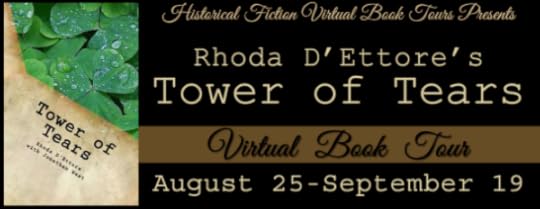
Please welcome Rhoda as she kindly stops here on her Historical Fiction Virtual Book Tour to discuss her new book. She has brought us a terrific guest post!!!
 The difficulties suffered by women of past generations who worked in factories to provide for their families is almost unimaginable to us today. Factory work took a toll on women physically, emotionally, and financially. In addition, factory work damaged the relationships with their partners and children.
The difficulties suffered by women of past generations who worked in factories to provide for their families is almost unimaginable to us today. Factory work took a toll on women physically, emotionally, and financially. In addition, factory work damaged the relationships with their partners and children. Physically, most factory workers of the past had to endure tiresomely long days. Standing on their feet, in the extreme cold and heat without modern temperature controls must have been unbearable. For most of American history, the factory workers received only Sundays off. At the time, Sunday was considered a day of rest due to stricter applications of biblical preachings. Overnight shifts and holidays were required, and factories often produced a lot of smog and pollution. Not only were the workers covered with soot, but they were inhaling it. They would blow their noses and the soot would be be expelled from the nose onto the handkerchief. Many factories required huge fires or boilers of some sort to produce the energy to power the equipment that was being used. Thus, adding to the extreme temperatures.
As second class citizens of decades past, women were often thought of as expendable. They were intimidated by threats that a man could replace them. Many women lost their jobs during pregnancy because the employer did not want to be concerned with physical limitations of the pregnant women. Nor did the employers want to lose an employee during the delivery and recovery period. Unlike seamstress or house servant jobs, factories put women side by side with male co-workers. Many women were sexually harassed or assaulted because the employers and male co-workers realized there was no place for the female worker to go. A woman who had a family could not just quit, file a lawsuit, or collect unemployment. She had to endure the disrespect and violation that her employers or co-workers wished to inflict upon her. It was a trap--a trap that was created by the society of men in power. The laws of the time stated that a woman could not be raped, claiming it was physically impossible. In her 2007 book, Rape: A History from 1860 to the present, author Joanna Bourke quoted directly from medical textbooks of the past that rape was impossible. The medical and legal profession claimed "it is impossible to sheath a sword into a vibrating scabbard." Immigrant women suffered even worse. Signs were often displayed “No Irish Need Apply”, causing more stress for women. This was the reality women faced, not just in the factories, but in all aspects of their lives.
 Some factories who employed women paid them much less than male counterparts. In addition, if the woman was an immigrant she was often paid even less. The only way for such women to be able to work and ensure care for their children would be to live with family. Often there would be groups of people living in one household that functioned as one unit. The large amount of people were often cramped into close quarters because wages were too low to pay for larger homes. It is nearly unfathomable for Americans today to repair shoes, or stuff items in their shoes to prolong wear. Darning socks is a thing of the past. These were amongst the things that were required of low paying factory workers in order to financially survive.
Some factories who employed women paid them much less than male counterparts. In addition, if the woman was an immigrant she was often paid even less. The only way for such women to be able to work and ensure care for their children would be to live with family. Often there would be groups of people living in one household that functioned as one unit. The large amount of people were often cramped into close quarters because wages were too low to pay for larger homes. It is nearly unfathomable for Americans today to repair shoes, or stuff items in their shoes to prolong wear. Darning socks is a thing of the past. These were amongst the things that were required of low paying factory workers in order to financially survive.In 1975, author Henry "Hank" Leiferman wrote of the struggles of one mill worker in his book Crystal Lee: A Woman of Inheritance. Crystal Lee Pulley fought for better working conditions and unionization of her mill. She was fired from the mill, yet gained a position with the union to improve conditions elsewhere. However, since 1976 the American textile industry has lost 2.6 million jobs. Although conditions improved, the jobs eventually disappeared. This left women unemployed and competing with others who were better educated.
Factory and/or warehouse life today still causes great hardships for women and their families. Many women are forced to work overnight shifts, weekends, and holidays. Having to work a shift such as 2:30pm to 11:00 pm causes a disconnect in the family because the mother only sees her children an hour or so before sending them off to school in the morning. By the time they return from school, she is already at work. The burdens of childcare costs are staggering. Often the woman is a single mother who lives paycheck to paycheck. Even unionized warehouse or factory establishments which have better conditions overall cause much stress amongst the families.
Although working conditions and the social status of women have improved over the last century, women are still facing obstacles in the workplace. Perhaps looking to their sisters of the past, women of the present can gain the strength to face their own struggles today.
***
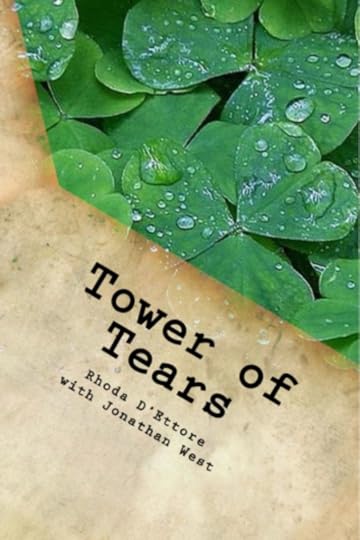 Betrayal. Despair. Murder. Mystery. Romance. Blackmail. "If God be good, Mr. Landon will burn in the eternal flames of hell. If God be bad, he will suffer much worse." In 1820, a young woman and her son leave Ireland for a better life in America. She soon suffers heartache and tragedy, while residing with family whom she has never met. Unbeknownst to her, the family had already set her up with employment in a factory--a factory run by a lecherous man. This is the first book in a series that will follow the McClusky family while they become Americanized while face with the Potato Famine, the US Civil War, and the Industrial Revolution.Publication Date: May 25, 2014
Betrayal. Despair. Murder. Mystery. Romance. Blackmail. "If God be good, Mr. Landon will burn in the eternal flames of hell. If God be bad, he will suffer much worse." In 1820, a young woman and her son leave Ireland for a better life in America. She soon suffers heartache and tragedy, while residing with family whom she has never met. Unbeknownst to her, the family had already set her up with employment in a factory--a factory run by a lecherous man. This is the first book in a series that will follow the McClusky family while they become Americanized while face with the Potato Famine, the US Civil War, and the Industrial Revolution.Publication Date: May 25, 2014 CreateSpace Independent Publishing
Formats: eBook, Paperback, Audio Book
Genre: Historical Fiction

READ AN EXCERPT.
Buy the Book
Amazon (Audio Book)Barnes & NobleBook DepositoryIndieBound
National Military Family Association

$1 per sale will be donated, regardless of what format is purchased---ebook, print, audiobook & regardless of site purchased---will be donated to the National Military Family Association. This organization helps families reconnect when the parents return from deployments, as well as helping families with other transitions and keeping the children active while the parents are deployed.
 About the AuthorRhoda D'Ettore was born in Woodbury, New Jersey, into a family of 5 siblings--which has provided her with plenty of comical material. She began working at the United States Postal Service at 25 years old, and over the past 15 years has accumulated many humorous stories about situations that the public never gets to know about. Her first ebook, "Goin' Postal: True Stories of a U.S. Postal Worker" was so popular that readers requested it in paperback. Recently, she published the humorous "Goin' Postal" in paperback along with another story entitled, "The Creek: Where Stories of the Past Come Alive". Combining these two into one book may seem strange, as one is humorous and the other is a heart wrenching historical fiction, however, doing so proves to the reader Rhoda D'Ettore's versatility.Rhoda D'Ettore received her degree in Human & Social Services while working at USPS, has travelled extensively, and loves history. Over the years she has volunteered for several community service organizations, including fostering abused and neglected dogs for a Dalmatian rescue.
About the AuthorRhoda D'Ettore was born in Woodbury, New Jersey, into a family of 5 siblings--which has provided her with plenty of comical material. She began working at the United States Postal Service at 25 years old, and over the past 15 years has accumulated many humorous stories about situations that the public never gets to know about. Her first ebook, "Goin' Postal: True Stories of a U.S. Postal Worker" was so popular that readers requested it in paperback. Recently, she published the humorous "Goin' Postal" in paperback along with another story entitled, "The Creek: Where Stories of the Past Come Alive". Combining these two into one book may seem strange, as one is humorous and the other is a heart wrenching historical fiction, however, doing so proves to the reader Rhoda D'Ettore's versatility.Rhoda D'Ettore received her degree in Human & Social Services while working at USPS, has travelled extensively, and loves history. Over the years she has volunteered for several community service organizations, including fostering abused and neglected dogs for a Dalmatian rescue.For more information please visit Rhoda's website. You can also find her on Facebook and Twitter.
Tower of Tears Blog Tour ScheduleMonday, August 25
Spotlight & Giveaway at What Is That Book About
Tuesday, August 26
Spotlight & Giveaway at Broken Teepee
Wednesday, August 27
Guest Post at Mythical Books
Friday, August 29
Spotlight & Giveaway at So Many Precious Books, So Little Time
Monday, September 1
Guest Post at Book Babe
Thursday, September 4
Review at CelticLady's Reviews
Monday, September 8
Interview & Giveaway at Historical Fiction Connection
Tuesday, September 9
Review at Griperang's Bookmarks
Thursday, September 11
Review at Jorie Loves a Story
Friday, September 12
Interview at Jorie Loves a Story
Monday, September 15
Review at WV Stitcher
Tuesday, September 16
Review & Giveaway at Beth's Book Reviews
Friday, September 19
Review at Unshelfish
Review & Giveaway at Brooke Blogs
Published on September 01, 2014 00:00
August 31, 2014
Freedom is Never Out of Style in Coco Chanel
 "Women have to dress for themselves, not for the pleasure of their men."
"Women have to dress for themselves, not for the pleasure of their men."I admire who this was, her agenda: to fashion clothes that allowed women to work, to breathe, to move as freely as men, to live.
I've always found some of her fashions a bit drab and shapeless, but there was a war on for a while there, you know.
This is the second movie I've watched about Coco. The first was Coco Before Chanel. I didn't care for it. It was about her being a mistress to a wealthy aristocrat and being snubbed by society and then it just kinda ended. While this one has her life as a mistress, it also gets a lot more into detail about the start-up of her business, the crescendo of her success. She goes from the orphanage, to a seamstress's shop, to being a man's mistress, to hatmaker, to....Coco, suffering broken hearts and abandonment the entire way.
From what I can find though, a lot of things were left out. Not a single movie has touched on her being accused of being a Nazi spy/informer during WWII. That's interesting and something I want to hear more about. The focus always seems to be her romance with Etienne and in this case, Boy.
 The actress CocoThe movie goes back and forth between old Coco, Shirley MacLaine in the late fifties(?) or early sixties, and to young Coco, played by a woman (Brigitte Boucher) who looks very much like a young Sally Field. Most of it was the young Coco, so I'm not sure why the star is considered Shirley. I think they should have made the young girl the star, as I almost didn't watch this movie in the first place. A near-death's-door Coco didn't interest me.
The actress CocoThe movie goes back and forth between old Coco, Shirley MacLaine in the late fifties(?) or early sixties, and to young Coco, played by a woman (Brigitte Boucher) who looks very much like a young Sally Field. Most of it was the young Coco, so I'm not sure why the star is considered Shirley. I think they should have made the young girl the star, as I almost didn't watch this movie in the first place. A near-death's-door Coco didn't interest me.What did interest me was how Coco revolutionized women's fashion during WWI. There's one scene in particular in which this stuck-up designer for the elite complains that her clothes are basically for the working woman. And Coco heartily agrees. Her clothes are for ALL women, working, upper class, etc. As during this time, women's servants were quitting/leaving and women had to dress themselves. And the poor were hard at work and needed to move. It was also just really neat to watch the fashions change as this movie played on.
Did you know she started as a hatmaker in a third-floor apartment in Paris that apparently felt like the North Pole?
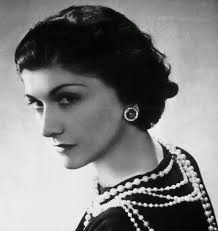 The real CocoI really enjoyed her romance with Boy too. I probably wouldn't have liked him in real life, mind you, but the this actor and this script...well, until he goes to England, I was rather in love with him myself. *sigh* And that's a compliment from me as I'm not that gaga about romance.
The real CocoI really enjoyed her romance with Boy too. I probably wouldn't have liked him in real life, mind you, but the this actor and this script...well, until he goes to England, I was rather in love with him myself. *sigh* And that's a compliment from me as I'm not that gaga about romance.This having been made for TV (Lifetime), the sex scenes are tasteful and contain no blatant nudity. This version of Coco is also a lot more likable than the one in Coco Before Chanel.
Long review short, this two-hour and ten-minute movie is def worth watching. It nicely sums up the beginning of Coco's success. Could it have had more? Yes, I'd have liked to have gone into WWII. But I enjoyed this very much. Perhaps C.W. Gortner's upcoming 2015 release Mademoiselle Chanel will get into more detail outside of the romance.
I rented this on Prime.

Published on August 31, 2014 00:00
August 30, 2014
Nell Donnelly Reed: More Than Just a Fashion-Starter
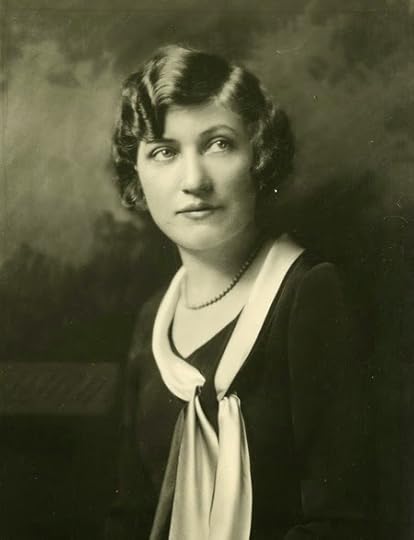 I learned about this woman on Mysteries at the Museum too. She invented the housedress, survived an abduction, started a very successful dress-making business, provided her employees with benefits (not common during her time), and had a long-standing love affair with a powerful senator. Why there isn't a movie about her or a historical novel *hint, hint, darling authors* is beyond me.
I learned about this woman on Mysteries at the Museum too. She invented the housedress, survived an abduction, started a very successful dress-making business, provided her employees with benefits (not common during her time), and had a long-standing love affair with a powerful senator. Why there isn't a movie about her or a historical novel *hint, hint, darling authors* is beyond me.She married at 17, yet that didn't stop her from going to college and then selling her dress designs at a local store. What started as two women sewing 216 dresses in Nell's attic in 1916 became the Donnelly Garment Company, which by 1953 "was the largest manufacturer of women's clothing worldwide."
Her workers actually resisted becoming unionized, and that's rare. She had a scholarship fund for her workers, financially supported their evening classes, provided insurance and medical financial aid, pensions, and even an on-site cafeteria and recreation center. And being a size 16 herself, Nell was adamant that her dresses look good on bigger women as well as small.
The abduction (at gunpoint) of her and her chauffeur was all about ransom. It was her secret (hm. Perhaps not so secret, considering she'd had a baby with him and her husband at the time knowingly adopted the child...) lover, former mayor and senator James A. Reed, who came to her aid by involving the local Kansas City mafia. The big man, a John Lazia tracked her down, but at that point, the perps had gotten wind that Lazia was after them and except for two lone waters, they'd hightailed it from the scene of the crime.
A mere two years later, she divorced her first husband and married Reed, recently widowed. After her retirement in 1956, the company she had worked so hard to build could not survive without her savvy designs and went bankrupt in 1978.
Nell lived to be 102. What a fascinating woman! Way ahead of her time. A designer, a survivor, a lover, a kind-hearted employer, and a successful woman who did what she wanted. Someone, write a novel based on her!
References:
http://en.wikipedia.org/wiki/Nell_Don...
http://shs.umsystem.edu/historicmisso... *Picture can be found on their site*
Published on August 30, 2014 00:00
August 29, 2014
Ten Questions from Tara: Interview with Hazel Woods (HFVBT)
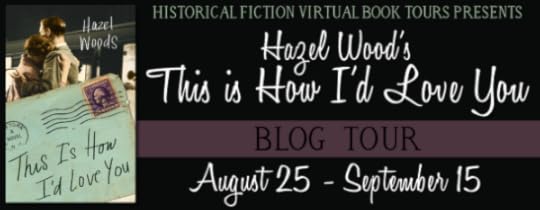
Tara: Welcome. You’re here to promote THIS IS HOW I’D LOVE YOU, a historical novel set during the Great War. Tell me, please, what was the inspiration behind this story? How did it come to you?
Hazel: Does it make me sound really nerdy if I say that this novel was inspired by a chess game? Well, there it is. I am a nerd, but not such a great chess player. My great-grandfather, on the other hand, was apparently quite a masterful player. And several years ago my mother mentioned that he had played chess via the post. He lived in a small town in southern New Mexico, but whenever my mother would visit, she remembers a separate chess board always mid-game, keeping track of the game he was playing with his current, long-distance opponent. This idea—that people could actually play a game over long periods of space and time—captured my imagination. Maybe because I have two children who have really come of age during this time of immediate gratification, I feel very nostalgic for a time when people had to be patient--a kind of patience that I’m not sure we can even fathom. In those gaps between letters, life continues and that creates a kind of obvious tension, which is such a gift for a writer.
Also, that same great-grandfather happened to be quite a romantic. He wrote the sweetest letters to my great-grandmother while the were courting and thankfully I come from a long line of pack-rats. I actually didn’t read too many of their letters until I’d finished writing the novel, but there are some real gems.
Tara: I think that's the BEST, most interesting answer I've ever received to that question. I LOVE when a family member in the past inspires a story today and the letters....*sighs dreamily*
We focus a lot on heroines here on Book Babe. Tell me what makes your heroine strong.
Hazel: Hensley reminds me of a lot of women who don’t know their own strength until it’s tested. She trusts the men in her life—her father, her brother, even her suitor—to make her decisions for her. But when she must confront the realities of her own life on her own, she begins to make choices for her self, sometimes directly opposed to their wishes for her. This fact alone, in 1917, shows tremendous strength. And, coming from someone who’s afraid of heights, what she does with that strong man in the circus is evidence of major girl-power.
Tara: Now I'm intrigued. Strong man in the circus?
Do you see any of yourself in her?
Hazel: I love that Hensley is not a victim. I try very hard to always be aware of my own ability to affect change, whether in a personal relationship or in a broader context. We both love to sew, though I’m afraid I’m not nearly as talented a seamstress as she is.
Tara: Was there any particular part of this story that was the hardest for you to write? Tell me why.
Hazel: The scenes with Lowell and Hensley in the theater were difficult. I wanted it to be clear that Lowell took advantage of Hensley, but I also wanted her budding sexuality to play a part in that. It was rough to balance the two.
Tara: What kind of research did you do when you penned this novel? Did anything surprising come up in your search?
Hazel: I tried to read a lot of first-hand accounts of soldiers. Even though I’d always heard about the brutality of the conflict, I was honestly shocked at the gruesome details of their lives and their injuries and deaths. It was utter chaos. Over nine million soldiers were killed and over six million civilians. Nobody was prepared for the kind of destruction and suffering that would occur.
Tara: And we must never forget that, and those men. *nods head*
What would you like readers to gain from reading your book? Is there a strong moral? Do you hope they will laugh, learn something about a particular subject/person, ponder a point?
Hazel: I really want readers to be transported. The great joy of reading is the ability to escape our own reality and enter another.
Tara: Your book takes place in Hillsboro, New Mexico. If I were a tourist, what would you recommend I see in this town/country?
Hazel: Gosh, if anyone travels to Hillsboro, New Mexico, give me a call and I’ll meet you for tea. It’s a little speck of a town now, home mostly to artists and retirees, all fifteen of them. But you can still see my great-grandparents’ house—one like I imagine Hensley and her father lived. It’s a lovely old adobe home, shaded by graceful cottonwood trees, surrounded by a rock wall.
Tara: Moving on to personal things...if you could time travel to absolute any time and place in history, where and when would you go and what is it that draws you to this time period? What would you do whilst there?
Hazel: Honestly, I would love to live in the 1920s. I think there was just enough technology like indoor plumbing, refrigeration and train travel to make life comfortable. I think it would be so gratifying to have been a suffragist and see that work pay off with the passage of the 19th Amendment.
Tara: Oooh. My thoughts exactly!!!!!!!!!!!!!!!
What’s the one thing you hope to accomplish before you die? Your main goal?
 Hazel: Oh, geez. I can barely create and implement a successful grocery list. That’s a big, terrifying question. I love the quote that says, “The idea is to die young as late as possible.” I think that’s a good goal.
Hazel: Oh, geez. I can barely create and implement a successful grocery list. That’s a big, terrifying question. I love the quote that says, “The idea is to die young as late as possible.” I think that’s a good goal.Tara: I’m a dog mom, so I always ask this. Do you have pets? If so, tell me about them and do provide pictures.
Hazel: I’m so glad you asked! Right now we have one rescue dog, Max. We adopted him last summer after we lost our beloved Border Terrier. Max is some kind of Lab, Pit Bull, Pointer mix, we think. He is a super dog with tricks like pulling tissues from the tissue boxone after another, catching flies mid-air, and leaning against the humans’ legs whenever we hug each other.
Tara: Hazel, it's been a true pleasure having you here today. I wish you the very best with your writing career and whatever other endeavors you pursue.
***
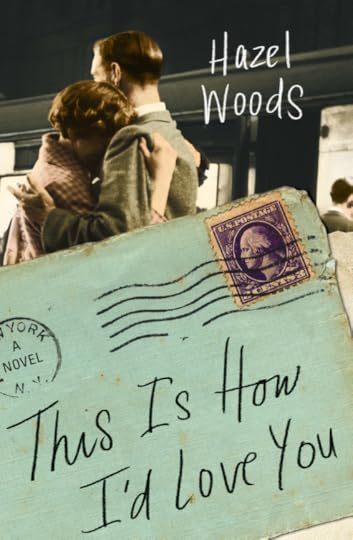 As the Great War rages, an independent young woman struggles to sustain love—and life—through the power of words. It’s 1917 and America is on the brink of World War I. After Hensley Dench’s father is forced to resign from the New York Times for his anti-war writings, she finds herself expelled from the life she loves and the future she thought she would have. Instead, Hensley is transplanted to New Mexico, where her father has taken a job overseeing a gold mine. Driven by loneliness, Hensley hijacks her father’s correspondence with Charles Reid, a young American medic with whom her father plays chess via post. Hensley secretly begins her own exchange with Charles, but looming tragedy threatens them both, and—when everything turns against them—will their words be enough to beat the odds?
As the Great War rages, an independent young woman struggles to sustain love—and life—through the power of words. It’s 1917 and America is on the brink of World War I. After Hensley Dench’s father is forced to resign from the New York Times for his anti-war writings, she finds herself expelled from the life she loves and the future she thought she would have. Instead, Hensley is transplanted to New Mexico, where her father has taken a job overseeing a gold mine. Driven by loneliness, Hensley hijacks her father’s correspondence with Charles Reid, a young American medic with whom her father plays chess via post. Hensley secretly begins her own exchange with Charles, but looming tragedy threatens them both, and—when everything turns against them—will their words be enough to beat the odds?Praise for This Is How I'd Love You
“In This is How I’d Love You, Hazel Woods explores the enduring nature of an improbable love born of words, washed in tragedy, and sustained despite impossible circumstances. With prose as immediate and evocative as a painting, Woods accomplishes the magic of rendering sorrow into hope and fear into courage. It is as idealistic a tale as it is clear-sighted, a brilliant alchemy few novels achieve. Readers, prepare to melt” — Robin Oliveria, author of My Name is Mary Sutter
Publication Date: August 26, 2014Plume BooksFormats: eBook, Paperback, MP3 CDPages: 320Genre: Historical Fiction
 Buy the Book<br />
Buy the Book<br /> Barnes & NobleIndieBoundPowell's
 About the AuthorHazel Woods lives in New Mexico with her husband and two children. For more information please visit www.hazelwoodsauthor.com. You can also find her on Twitter.
About the AuthorHazel Woods lives in New Mexico with her husband and two children. For more information please visit www.hazelwoodsauthor.com. You can also find her on Twitter.This Is How I'd Love You Blog Tour ScheduleMonday, August 25
Review & Giveaway at Flashlight Commentary
Wednesday, August 27
Interview at Dab of Darkness
Friday, August 29
Interview at Book Babe
Monday, September 1
Review & Interview at Closed the Cover
Tuesday, September 2
Review & Interview at A Chick Who Reads
Wednesday, September 3
Review at The Bookworm
Thursday, September 4
Review at Booktalk & More
Friday, September 5
Spotlight & Giveaway at So Many Precious Books, So Little Time
Monday, September 8
Spotlight & Giveaway at Historical Tapestry
Tuesday, September 9
Guest Post & Giveaway at Let Them Read Books
Wednesday, September 10
Interview at Caroline Wilson Writes
Friday, September 12
Review & Giveaway at A Bookish Affair
Spotlight at CelticLady's Reviews
Monday, September 15
Review & Guest Post at Bookish
Tuesday, September 16
Review at Book of Secrets
Wednesday, September 17
Review at Book Nerd
Published on August 29, 2014 00:00
August 28, 2014
From Battered Bride to Courageous Circus Teacher...The Language of Silence by Peggy Webb
 This is an inspiring tale, a story so engrossing that I if I hadn't had to work, if everyday life would have just let me be, I'd have read this book in a day. I didn't want to put it down.
This is an inspiring tale, a story so engrossing that I if I hadn't had to work, if everyday life would have just let me be, I'd have read this book in a day. I didn't want to put it down.There are two wonderful heroines in this. I absolutely LOVED Ruth. She's a spunkier-than-all-get-out old lady whose home is in the Ozarks. She has visions and tries to interpret them and wants nothing more than to save her battered niece and find out what happened to her own sister Lola years ago.
"You ain't gonna find nothin' here but a skinny old woman with a tough hide. Now, git."
Ruth had never seen anything, man nor beast that she couldn't outsmart, outlast, and outfight if she tried.
"Give me enough skeins of yarn, and I can knit a slipcover for the Empire State Building."
And the niece, Ellen. She's beaten black and blue by her husband and her own mother doesn't even believe her, and when she attempts to go to a shelter, she finds herself back in his un-loving arms. What can she do? She has so much courage in what she does. As the story unfolds, we watch her, with Ruth's help, grow a backbone of steel, stand up for herself, and follow her dreams. I loved her in the end, absolutely loved her. I recommend all women read this book.
She would not be her mother, she would not be June Cleaver, and she'd be damned if she'd let a backwoods woman from Tremont, Mississippi, be her hero, no matter how many hit records Wynette had.
But this is not just a battered-woman story, or even the story of a woman escaping. It's also about the circus family. It's about a special-ed teacher. It's about a woman in the past who worked with tigers. However, I wish there had been more of that stuff--a lot more. I feel Lola's story was not strong enough, nor was there enough of it, to really have any relevance to the modern story. And the circus family's acceptance of Ellen and Ruth--it was so sudden. I imagine some time went by, but how much? There's so little interaction with the people before suddenly she's one of the family. And as for her being a special-ed teacher, what and when does she actually teach? There's all of three scenes with her school kids and except for one reading session, they just seem to play and all of a sudden, a boy who couldn't speak is speaking.
I actually wish this book was longer so it could have expanded more on all those bits.
But I still really enjoyed this novel and its theme. Battered women need to have hope and this book delivers that.
I received this via Netgalley.

Published on August 28, 2014 00:00
August 27, 2014
#Giveaway & Review: Plantation Nation by Mercedes King

Sixteen year old Emma Cartwright runs away from her family’s South Carolina rice plantation after a slave is beaten to death. Determined to join the fight against slavery, Emma enlists in the Union Army disguised as a young man. Nothing could prepare her for the sacrifices needed—and for falling in love for the first time.
***
 ***My Review***
***My Review***I had a bit of a struggle reading this book at first, not because it isn't good or well written, but because I very recently read a similar story in P.G. Nagle's A Call to Arms. It's obvious to me the books are based on the same real-life woman, Sarah Emma Edmonds. In both books, the heroine joins the Union army during the Civil War, avoids battle by doing hospital work, becomes a spy briefly by coloring herself with silver nitrate, and has a romance with a superior: James. So I felt like I was reading nearly the same thing again, in a different style and words.
There are some differences. In this one, Emma begins as a Southern belle while in the previous mentioned book, the heroine was a bible sales"man" from Canada. The romance is also different. In this book it's cleaner. In the previous one I mentioned, it was rather crude and out of place--vulgar even. While this version of their romance could have used a bit more build up and passion--I really didn't feel it at all--and still have been clean, I'd say this "version" of Emma's romance is preferable.
What I like about this tellin of Emma's tale is how the book shows us the turmoil a Southern daughter must have felt. Example: Emma wants to end slavery, but at the same time, she worries how the rice will get harvested and how her sisters will survive if it doesn't get done. She can't have it both ways and even as she realizes this, she's torn. Yet she continues on her path with hopes of everyone having freedom.
And her worries about killing:
New doubts crept into her head. Could she really kill someone? Indeed, Emma wanted slavery put to death, but did she have the gall, the anger, the fortitude to kill someone over a misinterpretation of right wrong?
There were some things, however, that didn't make sense to me--all regarding her family. Her father "thought it was important to understand other peoples, especially when they weren't like us..." and this man, this same man who helped Cherokee Indians, was a slave owner? And her grandfather, what kind of wonderful g-pa walks in on his grand-daughter being harassed by his overseer and does nothing? And to let the man whip her???? Seriously?
Actually many of the characterizations in this book didn't seem consistent. Another example is James constantly trying to keep Emma out of harm's way or protesting her exploits, yet he gets upset when she suddenly wants to become a woman again and leave before an important battle. Um....huh?
Yet a thumbs up to Ms. King for creating a different ending to Emma's military career. Once we got past the silver nitrate episode, the book became more unique and Ms. King began veering from the predictable. I especially enjoyed when Emma and James infiltrate the Confederate camp. It also has an ending that I didn't see coming--none of that "woman soldier gets pregnant and sneaks away from the army" crap that seems to be done over and over. I love a surprise ending.

***
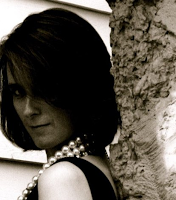
Mercedes King is an Ohio native and founding member of Sisters in Crime Columbus, Ohio (affectionately dubbed SiCCO). With a degree in Criminology from Capital University and a passion for writing, she crafted O! Jackie, a novel focusing on the private life of Jackie Kennedy. She has also written The Kennedy Chronicles, a series of short stories featuring JFK and Jackie before they were married and before 'Camelot'. Mercedes writes in a variety of genres, including historical and mystery / suspense. In fact, she's working on creating a new genre, 'modern historical'.
Her newest release, Plantation Nation, follows the journey of Emma Cartwright, a 16 year old Southern girl who disguises herself as a young man and joins the Union Army.
Visit her sites, OJackiebook.com or Mercedesking.com . Contact her at Mercedes 'at' ojackiebook 'dot' com. You can also connect with her on Facebook, Twitter, and Instagram.
Website: www.mercedesking.com
Facebook: https://www.facebook.com/mercedes.king.1806
Twitter: @Mercedes_King_
Blog: http://mercedeskingblog.blogspot.com
Instagram: mercedes_king_author
a Rafflecopter giveaway
Published on August 27, 2014 00:00



